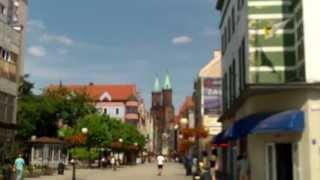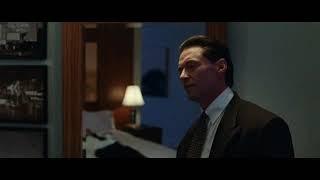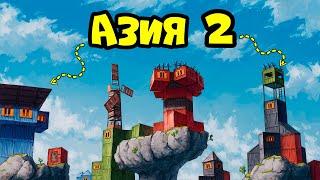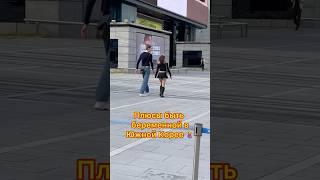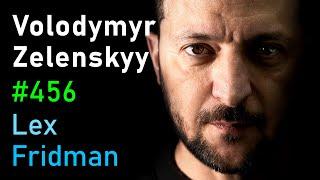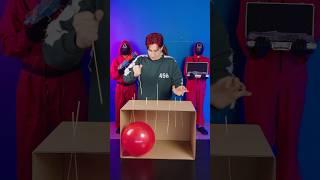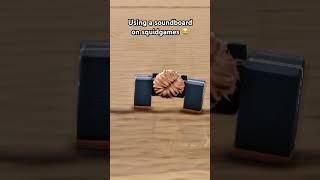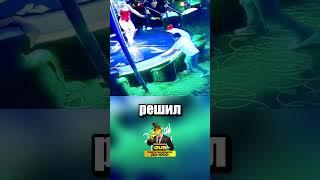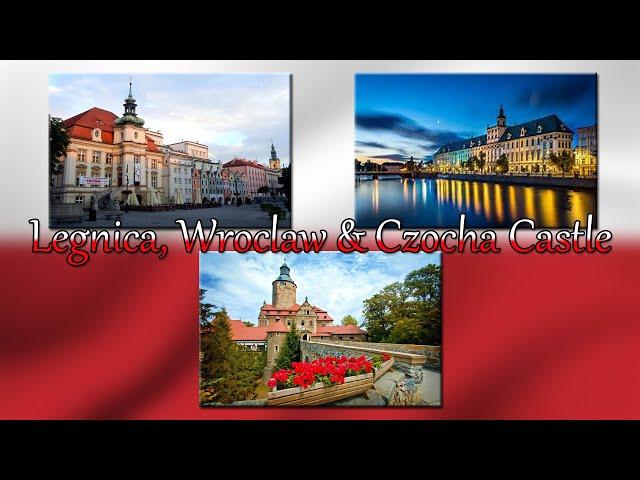
Poland - Legnica, Wroclaw & Czocha Castle
Buy Me A Coffee - https://www.buymeacoffee.com/ClassicRG
Legnica is a city in southwestern Poland, in the central part of Lower Silesia, on the Kaczawa River (left tributary of the Oder) and the Czarna Woda. Between 1 June 1975 and 31 December 1998 Legnica was the capital of the Legnica Voivodeship. It is currently the seat of the county and since 1992 the city has been the seat of a Diocese. As of 2020, Legnica had a population of 98,436 inhabitants.
Wrocław is a city in southwestern Poland and the largest city in the historical region of Silesia. It lies on the banks of the River Oder in the Silesian Lowlands of Central Europe, roughly 350 kilometres (220 mi) from the Baltic Sea to the north and 40 kilometres (25 mi) from the Sudeten Mountains to the south. The official population of Wrocław in 2020 was 641,928, with a further 1.25 million residing in the metropolitan area, making it the fourth largest city in Poland.
Wrocław is a university city with a student population of over 130,000, making it arguably one of the most youth-oriented cities in the country. Since the beginning of the 20th century, the University of Wrocław, previously Breslau University, has produced nine Nobel Prize laureates and is renowned for its high quality of teaching. Wrocław also possesses numerous historical landmarks, including the Main Market Square, Cathedral Island and the Centennial Hall, which is listed as a UNESCO World Heritage Site.
Czocha Castle is a defensive castle in the village of Czocha (Gmina Lesna), Lubań County, Lower Silesian Voivodeship, in southwestern Poland. The castle is located on the Lake Leśnia, near the Kwisa river, in what is now the Polish part of Upper Lusatia. Czocha castle was built on gneiss rock, and its oldest part is the keep, to which housing structures were later added.
Czocha Castle began as a stronghold, on the Bohemian-Lusatian border. Its construction was ordered by Wenceslaus I of Bohemia, in the middle of the 13th century (1241–1247). In 1253 castle was handed over to Konrad von Wallhausen, Bishop of Meissen. In 1319 the complex became part of the dukedom of Henry I of Jawor, and after his death, it was taken over by another Silesian prince, Bolko II the Small, and his wife Agnes (see Duchy of Silesia). Origin of the stone castle dates back to 1329.
In the mid-14th century, Czocha Castle was annexed by Charles IV, Holy Roman Emperor and King of Bohemia. Then, between 1389 and 1453, it belonged to the noble families of von Dohn and von Kluks. Reinforced, the complex was besieged by the Hussites in the early 15th century, who captured it in 1427, and remained in the castle for unknown time (see Hussite Wars). In 1453, the castle was purchased by the family of von Nostitz, who owned it for 250 years, making several changes through remodelling projects in 1525 and 1611. Czocha's walls were strengthened and reinforced, which thwarted a Swedish siege of the complex during the Thirty Years War. In 1703, the castle was purchased by Jan Hartwig von Uechtritz, influential courtier of Augustus II the Strong. On August 17, 1793, the whole complex burned in a fire.
In 1909, Czocha was bought by a cigar manufacturer from Dresden, Ernst Gutschow, who ordered major remodelling, carried out by Berlin architect Bodo Ebhardt, based on a 1703 painting of the castle. Gutschow, who was close to the Russian Imperial Court and hosted several White emigres in Czocha, lived in the castle until March 1945. Upon leaving, he packed up the most valuable possessions and moved them out.
After World War II, the castle was ransacked several times, both by soldiers of the Red Army, and Polish thieves, who came to the so-called Recovered Territories from central and eastern part of the country. Pieces of furniture and other goods were stolen, and in the late 1940s and early 1950s, the castle was home to refugees from Greece (see Greek Civil War). In 1952, Czocha was taken over by the Polish Army. Used as a military vacation resort, it was erased from official maps. The castle has been open to the public since September 1996 as a hotel and conference centre.
The complex was featured in several movies and television series, including a popular 1963 comedy, Gdzie jest generał? (Where is the General?), Legenda, The Hexer (film), The Hexer (TV series), Beyond Sherwood Forest, Spellbinder and serial The Secret of the Cipher Fortress.
Since 2014 the castle is also used as a setting for College of Wizardry, a live action role-playing game (LARP) that takes place in their own universe and can be compared to Harry Potter. There was a hiatus in 2019 after ongoing issues within its founding organization threatened to end the series. However, a crowdfunding action saved the LARP and a new organizing team has continued organizing events at the castle.
00:00 Legnica
02:34 Wroclaw
03:56 Czocha Castle
Legnica is a city in southwestern Poland, in the central part of Lower Silesia, on the Kaczawa River (left tributary of the Oder) and the Czarna Woda. Between 1 June 1975 and 31 December 1998 Legnica was the capital of the Legnica Voivodeship. It is currently the seat of the county and since 1992 the city has been the seat of a Diocese. As of 2020, Legnica had a population of 98,436 inhabitants.
Wrocław is a city in southwestern Poland and the largest city in the historical region of Silesia. It lies on the banks of the River Oder in the Silesian Lowlands of Central Europe, roughly 350 kilometres (220 mi) from the Baltic Sea to the north and 40 kilometres (25 mi) from the Sudeten Mountains to the south. The official population of Wrocław in 2020 was 641,928, with a further 1.25 million residing in the metropolitan area, making it the fourth largest city in Poland.
Wrocław is a university city with a student population of over 130,000, making it arguably one of the most youth-oriented cities in the country. Since the beginning of the 20th century, the University of Wrocław, previously Breslau University, has produced nine Nobel Prize laureates and is renowned for its high quality of teaching. Wrocław also possesses numerous historical landmarks, including the Main Market Square, Cathedral Island and the Centennial Hall, which is listed as a UNESCO World Heritage Site.
Czocha Castle is a defensive castle in the village of Czocha (Gmina Lesna), Lubań County, Lower Silesian Voivodeship, in southwestern Poland. The castle is located on the Lake Leśnia, near the Kwisa river, in what is now the Polish part of Upper Lusatia. Czocha castle was built on gneiss rock, and its oldest part is the keep, to which housing structures were later added.
Czocha Castle began as a stronghold, on the Bohemian-Lusatian border. Its construction was ordered by Wenceslaus I of Bohemia, in the middle of the 13th century (1241–1247). In 1253 castle was handed over to Konrad von Wallhausen, Bishop of Meissen. In 1319 the complex became part of the dukedom of Henry I of Jawor, and after his death, it was taken over by another Silesian prince, Bolko II the Small, and his wife Agnes (see Duchy of Silesia). Origin of the stone castle dates back to 1329.
In the mid-14th century, Czocha Castle was annexed by Charles IV, Holy Roman Emperor and King of Bohemia. Then, between 1389 and 1453, it belonged to the noble families of von Dohn and von Kluks. Reinforced, the complex was besieged by the Hussites in the early 15th century, who captured it in 1427, and remained in the castle for unknown time (see Hussite Wars). In 1453, the castle was purchased by the family of von Nostitz, who owned it for 250 years, making several changes through remodelling projects in 1525 and 1611. Czocha's walls were strengthened and reinforced, which thwarted a Swedish siege of the complex during the Thirty Years War. In 1703, the castle was purchased by Jan Hartwig von Uechtritz, influential courtier of Augustus II the Strong. On August 17, 1793, the whole complex burned in a fire.
In 1909, Czocha was bought by a cigar manufacturer from Dresden, Ernst Gutschow, who ordered major remodelling, carried out by Berlin architect Bodo Ebhardt, based on a 1703 painting of the castle. Gutschow, who was close to the Russian Imperial Court and hosted several White emigres in Czocha, lived in the castle until March 1945. Upon leaving, he packed up the most valuable possessions and moved them out.
After World War II, the castle was ransacked several times, both by soldiers of the Red Army, and Polish thieves, who came to the so-called Recovered Territories from central and eastern part of the country. Pieces of furniture and other goods were stolen, and in the late 1940s and early 1950s, the castle was home to refugees from Greece (see Greek Civil War). In 1952, Czocha was taken over by the Polish Army. Used as a military vacation resort, it was erased from official maps. The castle has been open to the public since September 1996 as a hotel and conference centre.
The complex was featured in several movies and television series, including a popular 1963 comedy, Gdzie jest generał? (Where is the General?), Legenda, The Hexer (film), The Hexer (TV series), Beyond Sherwood Forest, Spellbinder and serial The Secret of the Cipher Fortress.
Since 2014 the castle is also used as a setting for College of Wizardry, a live action role-playing game (LARP) that takes place in their own universe and can be compared to Harry Potter. There was a hiatus in 2019 after ongoing issues within its founding organization threatened to end the series. However, a crowdfunding action saved the LARP and a new organizing team has continued organizing events at the castle.
00:00 Legnica
02:34 Wroclaw
03:56 Czocha Castle
Тэги:
#legnica #wroclaw #czocha_castle #poland #travel #visit #holiday #city_break #polish_castles #zamek_czocha #polish #video_4k_ultra_hd #virtual_walk #wroclaw_poland #video_4k_ultra_hd_samsung #virtual_walking_tour #virtual_walks_around_the_world #virtual_walking_tours_around_the_world #wroclaw_poland_travel #wroclaw_poland_pronunciation #wroclaw_poland_vlog #travel_vlog #travel_tips #legnica_poland #poland_country #polish_language #wroclaw_walking_tourКомментарии:
Poland - Legnica, Wroclaw & Czocha Castle
The Classic And Retro Gamer
bull picture in ms word #msword #computer #shorts
VANYA CLASSES
Эмир и Рейхан Наконец-то это случилось ️
Videos for your soul
통증왕 대상포진 VS 통증왕 최봉춘
통증왕 최봉춘
pijat seluruh badan
Ardi trapis Pijat
COD Network Seller X Lighfunnels App
COD Network
Photographing Harvest Mice and Long Eared Owls.
Wildlife Photographer UK
A Beautiful City Legnica POLAND
dmbtraveler195
Hugh Jackman Gay Kiss - Bad Education
Male Movie Scenes
Birding at the Bear River Migratory Bird Refuge
Enthusiclast








